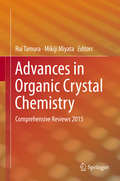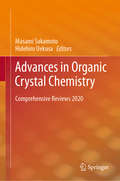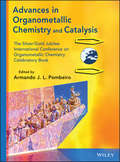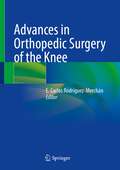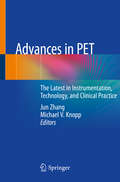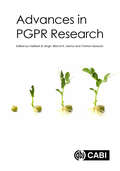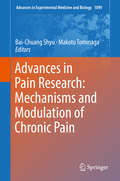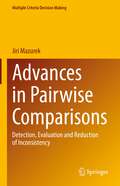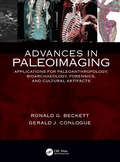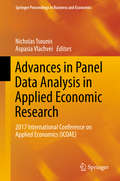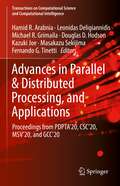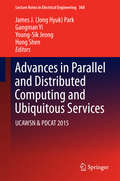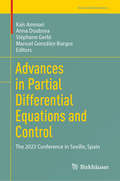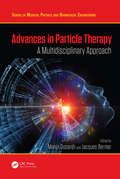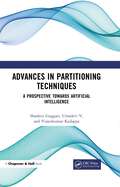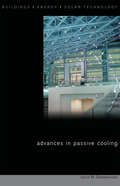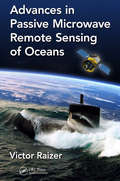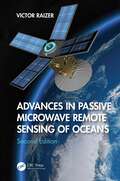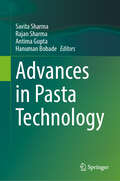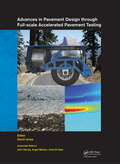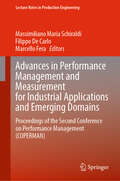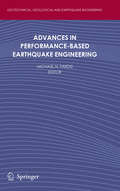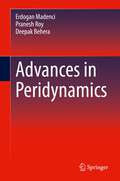- Table View
- List View
Advances in Orchid Biology, Biotechnology and Omics
by Jen-Tsung Chen Pragya TiwariThis book provides comprehensive insights into the existing and emerging trends in orchid biology based on the findings of omics, high-throughput technology, biotechnology, molecular breeding, and genome editing approaches in orchids. It illustrates molecular mechanisms of orchid mycorrhizal symbiosis according to the recent achievements of transcriptomics and bioinformatics studies which accelerate the progress of orchid research with the aid of their high-throughput tools. In this book, a comprehensive view of orchid breeding was presented, and it includes fundamental methods as well as advanced strategies through the combination of several technologies such as genetic engineering, omics, computational biology, and genome editing. These resulting knowledge and tools are highly beneficial for obtaining novel and fascinating varieties in the orchid market which is a competitive industry of global trade. Another interesting content is the focus on the production of orchid bioactive compounds and their values in the field of ethnomedicine. Their sources chiefly came from secondary metabolites and can be enriched through elicitors and produced more efficiently by improved tissue culture protocols and bioreactors. In this edited collection, we provided space for presenting an updated review of in vitro seed germination which is a routine technology for well-trained researchers but can give a complete demonstration for the potential audiences including growers and research beginners. This book collects refined knowledge from a broad source of scientific literature by experts in the field of orchid research and surely is an adequate reference and textbook for students, teachers, and researchers. It includes methods and applications of orchid breeding technology which would gain high attention from growers, breeders, and the related fields of agriculture.
Advances in Organic Crystal Chemistry: Comprehensive Reviews 2015
by Rui Tamura Mikiji MiyataFor the last decade, the topics of organic crystal chemistry have become diversified, and each topic has been substantially advanced in concert with the rapid development of various analytical and measurement techniques for solid-state organic materials. The aim of this book is to systematically summarize and record the recent notable advances in various topics of organic crystal chemistry involving liquid crystals and organic-inorganic hybrid materials that have been achieved mainly in the last 5 years or so. The authors are invited members of the Division of Organic Crystals, The Chemical Society of Japan (CSJ), and prominent invited experts from abroad. This edited volume is planned to be published periodically, at least every 5 years, with contributions by prominent authors in Japan and from abroad.
Advances in Organic Crystal Chemistry: Comprehensive Reviews 2020
by Masami Sakamoto Hidehiro UekusaThis book summarizes and records the recent notable advances in diverse topics in organic crystal chemistry, which has made substantial progress along with the rapid development of a variety of analysis and measurement techniques for solid organic materials. This review book is one of the volumes that are published periodically on this theme. The previous volume, published in 2015, systematically summarized the remarkable progress in assorted topics of organic crystal chemistry using organic solids and organic–inorganic hybrid materials during the previous 5 years, and it has been widely read. The present volume also shows the progress of organic solid chemistry in the last 5 years, with contributions mainly by invited members of the Division of Organic Crystal Chemistry of the Chemical Society of Japan (CSJ), together with prominent invited authors from countries other than Japan.
Advances in Organometallic Chemistry and Catalysis
by Armando J. PombeiroA contemporary compilation of recent achievements in organometallic chemistryThe prestigious International Conference on Organometallic Chemistry (ICOMC) was launched in 1963, providing a forum for researchers from around the world to share their findings and explore new paths to advance our knowledge and application of organometallic chemistry. The 25th ICOMC, held in Lisbon in 2012, gathered more than 1,200 participants from 54 countries. This volume celebrates the 25th Silver Edition and the 50th Gold Year of the ICOMC.Featuring contributions from invited 25th ICOMC speakers, Advances in Organometallic Chemistry and Catalysis highlights recent achievements and new and emerging areas of research in the field. Its seven sections cover:Activation and Functionalization of Carbon Single Bonds and Small MoleculesOrganometallic Synthesis and CatalysisOrganometallic Polymerization CatalysisOrganometallic Polymers and MaterialsOrganometallic Chemistry and Sustainable EnergyBioorganometallic ChemistryOrganometallic ElectrochemistryChapters discuss fundamental underlying concepts, offer illustrative examples and cases, and explore future avenues for continued research. Readers will discover basic principles and properties of organometallic compounds, reaction mechanisms, and detailed descriptions of current applications. Collectively, these chapters underscore the versatility, richness, and potential of modern organometallic chemistry, including its interrelationships with other scientific disciplines.All the contributions are extensively referenced, providing a gateway to the most important original research papers and reviews in organometallic chemistry. Presenting a contemporary understanding of organometallic chemistry and its many applications, Advances in Organometallic Chemistry and Catalysis is recommended for all researchers in the field, from students to advanced investigators.
Advances in Orthopedic Surgery of the Knee
by E. Carlos Rodríguez-MerchánThis book reviews current state-of-the-art knowledge on knee surgery, covering all relevant topics, ranging from meniscus repair and anterior cruciate ligament reconstruction to total knee arthroplasty. Although many of the interventions to treat meniscal, anterior cruciate ligament, patellofemoral osteoarthritis and femorotibial osteoarthritis are globally accepted, there are still many controversies as to which one is the most appropriate for each injury. Written by orthopedic surgeons from leading institutions specialized in the treatment of knee injuries, this volume critically discusses and sheds new light on these controversies.
Advances in PET: The Latest in Instrumentation, Technology, and Clinical Practice
by Jun Zhang Michael V. KnoppThis book is a guide to new and emerging PET technology, instrumentation, and its place in clinical practice. PET technology is currently moving from the conventional photomultiplier tube (PMT) detector based PET to the new generation, solid state light sensor detector. This is a technological leap and holds significant implications for the use of PET imaging. This book introduces and describes the emerging and new generation of PET instrumentations and technologies across manufactures, focusing on solid-state PET detector designs, system characteristics, and clinical practices as well as future advanced Time-of-Flight (TOF) PET technologies. Organized into three sections, the basics of PET imaging; solid state digital PET instrumentation, technology, and clinical practice; and a look to the future of PET imaging, chapters present a full picture of PET imaging, where we are and where we will be. Nuclear medicine physicians, physicists, and technologists can use this book to better understand future PET systems, novel PET technologies, and potential game changes of clinical PET practice.
Advances in PGPR Research
by Virendra S. Bisaria Randy Ortiz-Castro Robert Hill Jose López-Bucio Madhu Kamle Pradeep Kumar Dubey Rama Kant Dubey Kartikay Bisen Dr Chetan Keswani P. C. Abhilash Betina Cecilia Agaras Gautam Anand Laith K. Al-Ani Fabiola Padilla Arizmendi Fatima Berenice Salazar-Badillo Mansi Bakshi E. J. Bedmar Adrien Biessy Marieta Marin Bruzos Jesús Salvador López-Bucio Jorge Armando Mauricio-Castillo Vasvi Chaudhry Niladri Chaudhry Manoj Kumar Chitara Pooja Choudhary Manish Kumar Dubey Sheikh Adil Edirisi Martin Filion Elisabetta Franchi Deepika Goyal Natalia Cripps-Guazzone Antonio Castellano-Hinojosa Angela Cristina Ikeda María Fernanda Nieto-Jacobo Diwakar Kandula Gagan Kumar Punam Kumari Richard Daniel Lally Robert Lawry Guillermo Nogueira-López Anupam Maharshi Shrikant S. Mantri Rafael Jorge Marcillo Dmitri V. MavrodiRhizosphere biology is approaching a century of investigations wherein growth-promoting rhizomicroorganisms (PGPR) have attracted special attention for their ability to enhance productivity, profitability and sustainability at a time when food security and rural livelihood are a key priority. Bio-inputs - either directly in the form of microbes or their by-products - are gaining tremendous momentum and harnessing the potential of agriculturally important microorganisms could help in providing low-cost and environmentally safe technologies to farmers.One approach to such biologically-based strategies is the use of naturally occurring products such as PGPR. Advances in PGPR Research explores recent developments and global issues in biopesticide research, presented via extended case studies and up-to-date coverage of: · Low input biofertilizers and biofungicides used for sustainable agriculture. · Molecular techniques to enhance efficacy of microbial inputs. · Intellectual property issues in PGPR research. Written by an international team of experts, this book considers new concepts and global issues in biopesticide research and evaluates the implications for sustainable productivity. It is an invaluable resource for researchers in applied agricultural biotechnology, microbiology and soil science, and also for industry personnel in these areas.
Advances in PGPR Research
by Harikesh B. Singh Chetan Keswani Birinchi K. SarmaRhizosphere biology is approaching a century of investigations wherein growth-promoting rhizomicroorganisms (PGPR) have attracted special attention for their ability to enhance productivity, profitability and sustainability at a time when food security and rural livelihood are a key priority. Bio-inputs - either directly in the form of microbes or their by-products - are gaining tremendous momentum and harnessing the potential of agriculturally important microorganisms could help in providing low-cost and environmentally safe technologies to farmers. One approach to such biologically-based strategies is the use of naturally occurring products such as PGPR. Advances in PGPR Research explores recent developments and global issues in biopesticide research, presented via extended case studies and up-to-date coverage of: #65533; Low input biofertilizers and biofungicides used for sustainable agriculture. #65533; Molecular techniques to enhance efficacy of microbial inputs. #65533; Intellectual property issues in PGPR research. Written by an international team of experts, this book considers new concepts and global issues in biopesticide research and evaluates the implications for sustainable productivity. It is an invaluable resource for researchers in applied agricultural biotechnology, microbiology and soil science, and also for industry personnel in these areas.
Advances in Pain Research: Mechanisms and Modulation of Chronic Pain (Advances in Experimental Medicine and Biology #1099)
by Bai-Chuang Shyu Makoto TominagaThis book summarizes the latest advances in pain research. All the chapters were contributed by speakers from Asian Pain Symposium (APS) on Acute and Chronic Pain, which was held in Taipei in 2017. Founded in Kyoto, Japan in 2000, the APS serves as a platform for scientists to present recent findings in pain research and discuss research orientation in this field. APS 2017 focused on novel strategies for pain treatment. Written by experts from various disciplines, from molecular to functional, and from basic to clinic studies, this book is composed of 18 review articles on the physiology and pathology of pain in these research fields. Specific topics include circuitry, neurotransmitter, physiology, behavior, neuropathology, pharmacology, and the treatments for neuropathic pain disorders. The book is a valuable resource for researchers and graduate students in pain medicine and neuroscience.
Advances in Pairwise Comparisons: Detection, Evaluation and Reduction of Inconsistency (Multiple Criteria Decision Making)
by Jiri MazurekThis book tackles issues associated with inconsistency in pairwise comparisons from both theoretical and practical perspectives. Human judgments are seldom absolutely consistent, or absolutely precise, therefore problems of measuring and handling inconsistency belong among hot topics of the current research, especially in the theoretical framework of multiple criteria decision aiding (MCDA). The book presents and discusses the state-of-the-art of this field including both cardinal and ordinal inconsistency, the problems of different scales for comparisons and inconsistency reduction, and the alternative approaches to inconsistency detection and measurement. This book is a unique one-stop guide for readers who are interested in inconsistency in pairwise comparisons. Researchers and practitioners in the area of multiple-criteria decision-making (MCDM) and the analytic hierarchy process (AHP) will find this informative book particularly valuable.
Advances in Paleoimaging: Applications for Paleoanthropology, Bioarchaeology, Forensics, and Cultural Artefacts
by Ronald G. Beckett Gerald J. ConlogueAdvances in Paleoimaging: Applications for Paleoanthropology, Bioarchaeology, Forensics, and Cultural Artifacts builds on the research and advances in technology since the writing of the authors’ first book, Paleoimaging: Field Applications for Cultural Remains and Artifacts (ISBN: 978-1-4200-9071-0). Since Paleoimaging was published in 2009, additional research settings for the application of advanced imaging technologies have been identified. Practices are now more widespread and standardized with the capabilities and utilization of imaging methodologies increasing dramatically. Given the numerous advances in paleoimaging technique and technology, this book chronicles the evolution that has taken place in all the imaging modalities. Chapters include the coverage of magnetic resonance imaging, computed tomography, plane and digital radiography, endoscopy, and applications of x-ray fluorescence, as well as the principles of industrial radiography. While the book focuses on a multimodal imaging approach to anthropological and archaeological research, the authors and contributing authors have vast experience in other areas and present coverage of biological applications as well. The multidisciplinary chapters provide a foundation to understand the application of various imaging modalities in archaeological, anthropological, bioanthropological, and forensic settings. As such, Advances in Paleoimaging will serve as an essential reference for conservators, museum archivists, forensic anthropologists, paleopathologists, and archaeologists, who perform non-destructive research on historical or culturally significant artifacts, remains, or material from a forensic investigation. The concepts and methods presented in this text are supported with case presentations of the authors' vast experience in the new companion book, Case Studies for Advances in Paleoimaging (ISBN: 978-0-367-25166-6) by Beckett, Conlogue, and Nelson (2020).
Advances in Panel Data Analysis in Applied Economic Research: 2017 International Conference On Applied Economics (icoae) (Springer Proceedings In Business And Economics)
by Nicholas Tsounis Aspasia VlachveiThis proceedings volume presents new methods and applications in applied economic research with an emphasis on advances in panel data analysis. Featuring papers presented at the 2017 International Conference on Applied Economics (ICOAE) held at Coventry University, this volume provides current research on econometric panel data methodologies as they are applied in microeconomics, macroeconomics, financial economics and agricultural economics. <P><P> International Conference on Applied Economics (ICOAE) is an annual conference that started in 2008 designed to bring together economists from different fields of applied economic research in order to share methods and ideas. Applied economics is a rapidly growing field of economics that combines economic theory with econometrics to analyse economic problems of the real world usually with economic policy interest. In addition, there is growing interest in the field for panel data estimation methods, tests and techniques. This volume makes a contribution in the field of applied economic research in this area. Featuring country specific studies, this book will be of interest to academics, students, researchers, practitioners, and policy makers in applied economics and economic policy.
Advances in Parallel & Distributed Processing, and Applications: Proceedings from PDPTA'20, CSC'20, MSV'20, and GCC'20 (Transactions on Computational Science and Computational Intelligence)
by Hamid R. Arabnia Leonidas Deligiannidis Fernando G. Tinetti Michael R. Grimaila Douglas D. Hodson Kazuki Joe Masakazu SekijimaThe book presents the proceedings of four conferences: The 26th International Conference on Parallel and Distributed Processing Techniques and Applications (PDPTA'20), The 18th International Conference on Scientific Computing (CSC'20); The 17th International Conference on Modeling, Simulation and Visualization Methods (MSV'20); and The 16th International Conference on Grid, Cloud, and Cluster Computing (GCC'20). The conferences took place in Las Vegas, NV, USA, July 27-30, 2020. The conferences are part of the larger 2020 World Congress in Computer Science, Computer Engineering, & Applied Computing (CSCE'20), which features 20 major tracks. Authors include academics, researchers, professionals, and students.Presents the proceedings of four conferences as part of the 2020 World Congress in Computer Science, Computer Engineering, & Applied Computing (CSCE'20);Includes the research tracks Parallel and Distributed Processing, Scientific Computing, Modeling, Simulation and Visualization, and Grid, Cloud, and Cluster Computing;Features papers from PDPTA’20, CSC’20, MSV’20, and GCC’20.
Advances in Parallel and Distributed Computing and Ubiquitous Services: UCAWSN & PDCAT 2015 (Lecture Notes in Electrical Engineering #368)
by Hong Shen James J. Jong Hyuk Park Gangman Yi Young-Sik JeongThis book contains the combined proceedings of the 4th International Conference on Ubiquitous Computing Application and Wireless Sensor Network (UCAWSN-15) and the 16th International Conference on Parallel and Distributed Computing, Applications and Technologies (PDCAT-15). The combined proceedings present peer-reviewed contributions from academic and industrial researchers in fields including ubiquitous and context-aware computing, context-awareness reasoning and representation, location awareness services, and architectures, protocols and algorithms, energy, management and control of wireless sensor networks. The book includes the latest research results, practical developments and applications in parallel/distributed architectures, wireless networks and mobile computing, formal methods and programming languages, network routing and communication algorithms, database applications and data mining, access control and authorization and privacy preserving computation.
Advances in Partial Differential Equations and Control: The 2023 Conference in Seville, Spain (Trends in Mathematics)
by Kaïs Ammari Stéphane Gerbi Anna Doubova Manuel González-BurgosThis volume presents a timely overview of control theory and related topics, such as the reconstruction problem, the stability of PDEs, and the Calderón problem. The chapters are based on talks given at the conference "Control & Related Fields” held in Seville, Spain in March 2023. In addition to providing a snapshot of these areas, chapters also highlight breakthroughs on more specific topics, such as:Stabilization of an acoustic systemThe Kramers-Fokker-Planck operatorControl of parabolic equationsControl of the wave equationAdvances in Partial Differential Equations and Control will be a valuable resource for both established researchers as well as more junior members of the community.
Advances in Particle Therapy: A Multidisciplinary Approach (Series in Medical Physics and Biomedical Engineering)
by Jacques Bernier Manjit DosanjhHadron therapy is a groundbreaking new method of treating cancer. Boasting greater precision than other therapies, this therapy is now utilised in many clinical settings and the field is growing. More than 50 medical facilities currently perform (or are planned to perform) this treatment, with this number set to double by 2020. This new text covers the most recent advances in hadron therapy, exploring the physics, technology, biology, diagnosis, clinical applications, and economics behind the therapy. Providing essential and up-to-date information on recent developments in the field, this book will be of interest to current and aspiring specialists from a wide range of backgrounds. Features: Multidisciplinary approach: explores the physics, IT (big data), biology, clinical applications from imaging to treatment, clinical trials, and economics associated with hadron therapy Contains the latest research and developments in this rapidly evolving field, and integrates them into the current global challenges for radiation therapy Edited by recognised leaders in the field, including the co-ordinator of ENLIGHT (the European Network for Light Ion Hadron Therapy), with chapter contributions from international leading experts in the field
Advances in Partitioning Techniques: A Prospective towards Artificial Intelligence
by Shankru Guggari Umadevi V Vijayakumar KadappaThis book discusses various partitioning strategies tailored for traditional machine learning algorithms. It examines how data can be divided efficiently to enhance the performance and scalability of classic machine learning models. It explores how partitioning methods can be applied to neural networks and other deep learning architectures and describes various ways to accelerate training, reduce memory consumption, and enhance overall efficiency.Graphs are prevalent in various AI domains. This book is specifically designed for graph data structures using partitioning techniques and also explores insights into optimizing graph algorithms and analytics. With the explosion of data, efficient partitioning becomes crucial for processing large datasets. This book discusses various partitioning techniques that enable effective management and analysis of big data, enhancing speed and resource utilization. Edge computing demands resource-efficient strategies. It examines partitioning methods tailored for edge devices, enabling AI capabilities at the edge while addressing resource. This book showcases how partitioning techniques have been successfully applied across various AI domains. It demonstrates real-world scenarios where partitioning optimizes AI algorithms and systems.By bridging the gap between theory and practical applications, this book intends to equip researchers, practitioners, and students with invaluable insights into harnessing partitioning for optimizing AI-driven systems, data processing, and problem-solving strategies. It describes the various advantages and disadvantages of partitioning techniques. This book is a vital resource, illuminating the path towards unlocking the full potential of partitioning in shaping the future of AI technologies.
Advances in Passive Cooling: Advances In Passive Cooling (BEST (Buildings Energy and Solar Technology))
by Mat SantamourisFollowing a rapid increase in the use of air conditioning in buildings of all types, the energy demand for powering such devices has become a significant cause for concern. Passive cooling is increasingly being thought of as the best alternative to air conditioning. This book offers the latest knowledge and techniques on passive cooling, enabling building professionals to understand the state of the art and employ relevant new strategies. With separate chapters on comfort, urban microclimate, solar control, ventilation, ground cooling and evaporative and radiative cooling, this authoritative text will also be invaluable for architects, engineers and students working on building physics and low-energy design. Advances in Passive Cooling is part of the BEST series, edited by Mat Santamouris. The aim of the series is to present the most current, high quality theoretical and application oriented material in the field of solar energy and energy efficient buildings. Leading international experts cover the strategies and technologies that form the basis of high-performance, sustainable buildings, crucial to enhancing our built and urban environment.
Advances in Passive Microwave Remote Sensing of Oceans
by Victor RaizerThis book demonstrates the capabilities of passive microwave technique for enhanced observations of ocean features, including the detection of (sub)surface events and/or disturbances while laying out the benefits and boundaries of these methods. It represents not only an introduction and complete description of the main principles of ocean microwave radiometry and imagery, but also provides guidance for further experimental studies. Furthermore, it expands the analysis of remote sensing methods, models, and techniques and focuses on a high-resolution multiband imaging observation concept. Such an advanced approach provides readers with a new level of geophysical information and data acquisition granting the opportunity to improve their expertise on advanced microwave technology, now an indispensable tool for diagnostics of ocean phenomena and disturbances.
Advances in Passive Microwave Remote Sensing of Oceans
by Victor RaizerThis new edition introduces the fundamentals of passive microwave remote sensing of oceans, including the physical principles of microwave radiometry, novel observational data, their interpretation, and applications. It not only demonstrates and examines the recent advantages and state of the art of microwave data but also provides guidance for explaining complex ocean studies and advanced applications. All chapters are thoroughly updated with detailed analysis of space‑based microwave missions, and a new chapter on space‑based microwave radiometer experiments has been added. This book discusses the power of microwave remote sensing as an efficient tool for diagnostics of ocean phenomena in research and education.Features New to this Edition:• Includes a new chapter and additional data, images, illustrations, and references.• Uses ocean microwave data, acquired from different platforms, to illustrate different methods of analysis and interpretation.• Updates information on recent and important satellite missions dedicated to microwave remote sensing of oceans.• Offers more detailed analysis of multiband microwave data and images.• Provides examples of microwave data that cover different ocean environmental phenomena and hydro‑physical fields, including global and local ocean features.• Presents additional material on advanced applications, including detection capabilities.This book is intended for postgraduate students and professionals working in fields related to remote sensing, geography, oceanography, civil, environmental, and geotechnical engineering.
Advances in Pasta Technology
by Rajan Sharma Savita Sharma Antima Gupta Hanuman BobadePasta is a conventional Italian product made from durum wheat semolina and characterized by high protein content, firm shape and texture. Extrusion technology allows incorporation of a variety of ingredients to pasta such as legumes, millets, pseudo cereals and others including mushrooms, tubers and pigmented components to enrich conventional pasta. It is a convenient, popular and versatile product, offering the food industry and researchers the opportunity to offer high nutritional quality by using alternative ingredients of nutritive excellence with a high concentration of bioactive components which induce several health benefits through antioxidative pathways. To deal with compromised functional properties of resultant pasta, different techno-functional interventions including use of hydrocolloids and modification of flours which are used to improve rheological and textural profile are necessary.Advances in Pasta Technology documents the history of pasta and its rise from niche to mainstream. The book is divided into 4 sections including an introduction that covers pasta history, global market statistics, traditional pasta making technology and processing along with quality characteristics. Another section is dedicated to nutritive valorization of pasta including modulation in the bio-functional characteristics as a function of ingredients including development of gluten free pasta, micronutrient fortification approach and use of protein, fibre and antioxidant rich flours as potential alternative ingredients. Further sections focus on technological approaches to enhance the performance of specialty pasta including additives, modification of flours and processing techniques and quality management, plant project profile and cost analysis details. This text highlights every aspect of pasta science, technology and market control.
Advances in Pavement Design through Full-scale Accelerated Pavement Testing
by Ian MuehlenhausPack: Book and CDInternationally, full-scale accelerated pavement testing, either on test roads or linear/circular test tracks, has proven to be a valuable tool that fills the gap between models and laboratory tests and long-term experiments on in-service pavements. Accelerated pavement testing is used to improve understanding of pavement behavior,
Advances in Performance Management and Measurement for Industrial Applications and Emerging Domains: Proceedings of the Second Conference on Performance Management (COPERMAN) (Lecture Notes in Production Engineering)
by Marcello Fera Massimiliano Maria Schiraldi Filippo De CarloThis book is a compilation of the papers presented at the COPERMAN 2023 conference, a meeting that bridges the gap between academia and industry in the field of performance management. This international conference brought together scientists and engineers from around the world to discuss and address many themes related to performance management, including the development of new methods and systems for performance measurement and management, the evaluation of human performance in various industrial contexts (including modern Industry 4.0 factory environments), and methodologies for business deployment. The book is for academics, graduate students, researchers, and industrial practitioners working in performance management. Its comprehensive coverage of diverse topics and cutting-edge research will provide readers with insights and knowledge that can be applied in their daily work, as well as inspire new research directions and interdisciplinary collaboration.
Advances in Performance-Based Earthquake Engineering (Geotechnical, Geological and Earthquake Engineering #13)
by Michael N. FardisPerformance-based Earthquake Engineering has emerged before the turn of the century as the most important development in the field of Earthquake Engineering during the last three decades. It has since then started penetrating codes and standards on seismic assessment and retrofitting and making headway towards seismic design standards for new structures as well. The US have been a leader in Performance-based Earthquake Engineering, but also Europe is a major contributor. Two Workshops on Performance-based Earthquake Engineering, held in Bled (Slovenia) in 1997 and 2004 are considered as milestones. The ACES Workshop in Corfu (Greece) of July 2009 builds on them, attracting as contributors world-leaders in Performance-based Earthquake Engineering from North America, Europe and the Pacific rim (Japan, New Zealand, Taiwan, China). It covers the entire scope of Performance-based Earthquake Engineering: Ground motions for performance-based earthquake engineering; Methodologies for Performance-based seismic design and retrofitting; Implementation of Performance-based seismic design and retrofitting; and Advanced seismic testing for performance-based earthquake engineering. Audience: This volume will be of interest to scientists and advanced practitioners in structural earthquake engineering, geotechnical earthquake engineering, engineering seismology, and experimental dynamics.
Advances in Peridynamics
by Erdogan Madenci Pranesh Roy Deepak BeheraThis book presents recent improvements in peridynamic modeling of structures. It provides sufficient theory and numerical implementation helpful to both new and existing researchers in the field. The main focus of the book is on the non-ordinary state-based (NOSB) peridynamics (PD) and its applications for performing finite deformation. It presents the framework for modeling high stretch polymers, viscoelastic materials, thermoelasticity, plasticity, and creep. It provides a systematic derivation for dimensionally reduced structures such as axisymmetric structures and beams. Also, it presents a novel approach to impose boundary conditions without suffering from displacement kinks near the boundary. Furthermore, it presents refinements to bond-based PD model by including rotation kinematics for modeling isotropic and composite materials. Moreover, it presents a PD – FEM coupling framework in ANSYS based on principle for virtual work. Lastly, it presents an application of neural networks in the peridynamic (PINN) framework. Sample codes are provided for readers to develop hands-on experience on peridynamic modeling. Describes new developments in peridynamics and their applications in the presence of material and geometric nonlinearity; Describes an approach to seamlessly couple PD with FE; Introduces the use of the neural network in the PD framework to solve engineering problems;Provides theory and numerical examples for researchers and students to self-study and apply in their research (Codes are provided as supplementary material);Provides theoretical development and numerical examples suitable for graduate courses.

